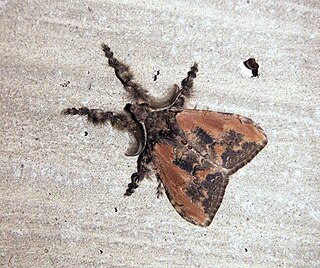
Olene mendosa, the brown tussock moth or hairy tussock moth, is a moth of the family Erebidae. The species was first described by Jacob Hübner in 1823. It is found in India, Bangladesh, Sri Lanka, Indonesia, Taiwan, Thailand and Australia.

Claterna is a monotypic moth genus of the family Noctuidae erected by Francis Walker in 1858. Its only species, Claterna cydonia, was first described by Pieter Cramer in 1775.

Trigonodes hyppasia, the triangles or semi-looper, is a moth in the family Erebidae. The species was first described by Pieter Cramer in 1779. It is largely cosmopolitan, found throughout Borneo, Fiji, India, Nepal, Sri Lanka, São Tomé and Príncipe, Taiwan, Zimbabwe, northern Australia, and almost all African countries.

Hyposidra talaca, the black looper or black inch worm, is a moth of the family Geometridae. The species was first described by Francis Walker in 1860. It is found from India to Indochina, Sundaland, Sulawesi, the Philippines, Sri Lanka, the Solomon Islands, Thailand, Taiwan, New Guinea and Australia, where it has been recorded from Queensland. It is a major defoliating pest in tea plantations.
Suana concolor is a moth of the family Lasiocampidae first described by Francis Walker in 1855. It is found in India and Sri Lanka, to South China, Java, Borneo and the Philippines.
Belciana biformis is a moth of the family Noctuidae first described by Francis Walker in 1858.

Diomea rotundata is a moth of the family Noctuidae first described by Francis Walker in 1857. It is found in Sri Lanka, the Indian subregion, Taiwan, Sumatra, Borneo, the Philippines and Sumba.
Episparis liturata is a moth of the family Noctuidae first described by George Hampson in 1893. It is found in India, Sri Lanka, Java, Borneo, Myanmar, China and Thailand.
Chorodna strixaria is a moth of the family Geometridae first described by Achille Guenée in 1858. It is found in India, Vietnam, Sulawesi, the Philippines, the Moluccas, New Guinea, Australia and Sri Lanka.

Gonodontis clelia is a moth in the family Geometridae first described by Pieter Cramer in 1780. It is found in Sri Lanka, South India, Pakistan, Nepal, Hong Kong, the Andaman Islands, Singapore, Borneo and Australia.
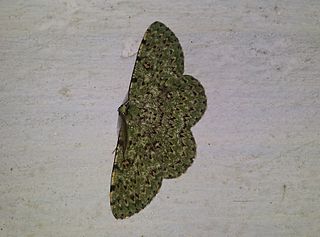
Ophthalmitis herbidaria is a moth of the family Geometridae first described by Achille Guenée in 1858. It is found in China, India, Sri Lanka, Nepal, Hong Kong and Taiwan.
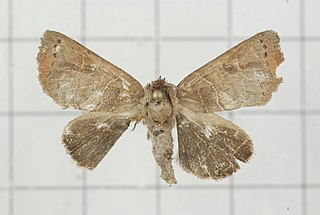
Clostera restitura is a moth of the family Notodontidae first described by Francis Walker in 1865. It is found in Oriental tropics of India, Sri Lanka, and from Hong Kong to Sundaland.

Callyna monoleuca is a moth of the family Noctuidae first described by Francis Walker in 1858. It is found in Sri Lanka, India, China, Japan, Taiwan, Myanmar, Indonesia, New Guinea and Australia.

Hipoepa biasalis is a moth of the family Noctuidae first described by Francis Walker in 1859. It is found in Oriental tropics of India and Sri Lanka to Taiwan, Sumatra, Borneo, the Philippines and Sulawesi.
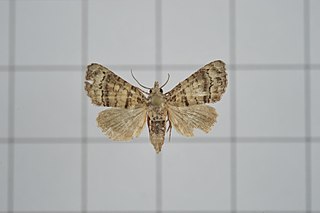
Chlumetia transversa, the mango shoot borer, is a moth of the family Euteliidae. The species was first described by Francis Walker in 1863. It is a widely distributed across Indo-Australian tropical countries far east to Solomon Islands.
Stenopterygia subcurva is a moth of the family Noctuidae first described by Francis Walker in 1857. It is found in Sri Lanka.
Leucania venalba is a moth of the family Noctuidae first described by Frederic Moore in 1867. It is found in Indo-Australian tropics of India, Sri Lanka, to Fiji and New Caledonia.
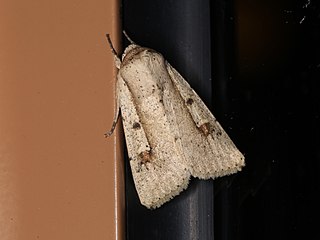
Leucania yu is a moth of the family Noctuidae first described by Achille Guenée in 1852. It is found in Oriental tropics of India, Sri Lanka, the Andaman Islands, Hong Kong, Indonesia, the Philippines, Taiwan east to Australia, Fiji and Tonga.
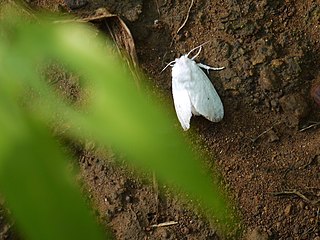
Altha subnotata is a moth of the family Limacodidae first described by Francis Walker in 1865. It is found in Sri Lanka, India and Nepal.

Xenochroa chlorostigma is a moth of the family Nolidae first described by George Hampson in 1893. It is found in India, Sri Lanka, Himalaya, Sundaland, Philippines and Sulawesi.














